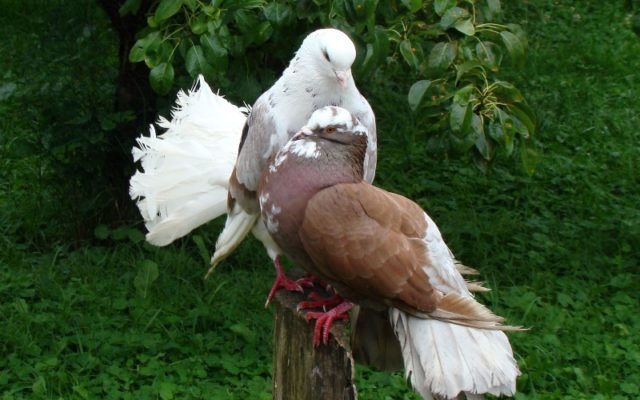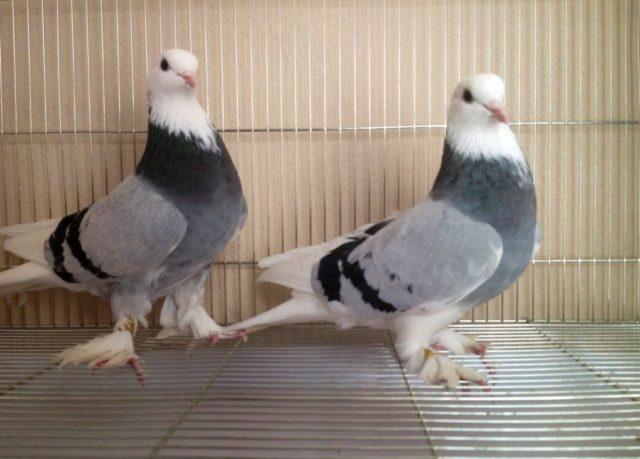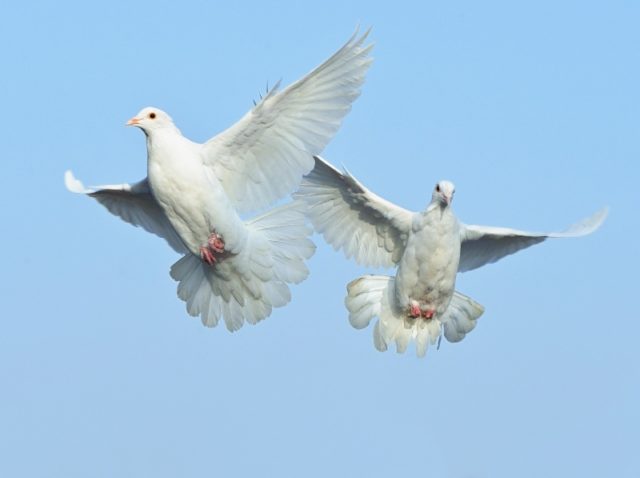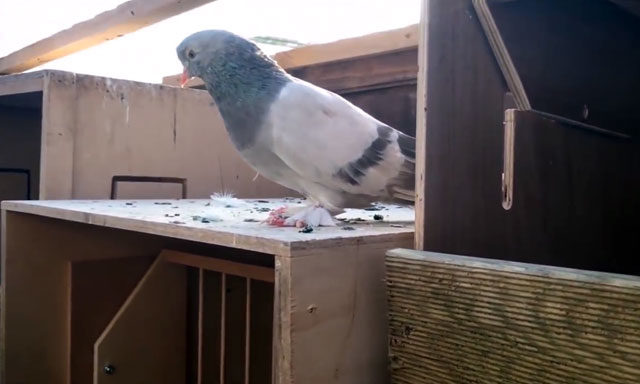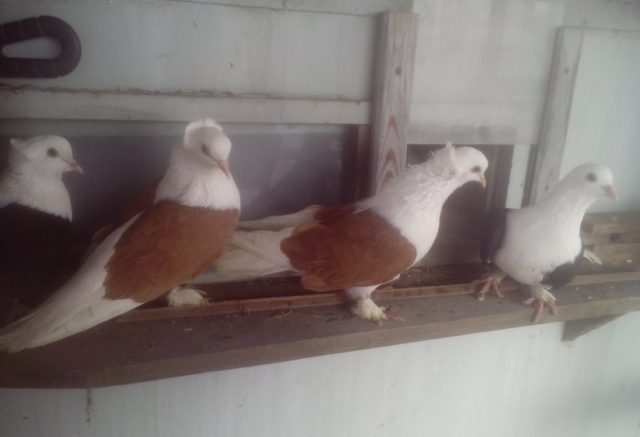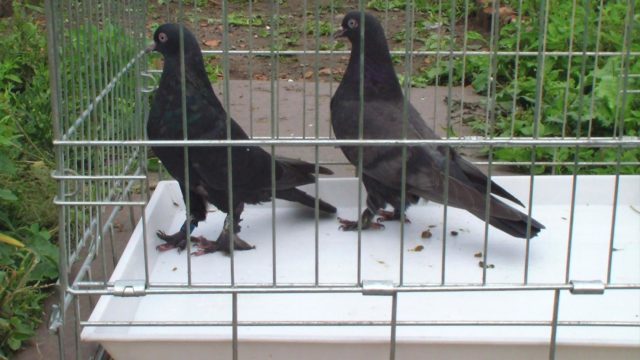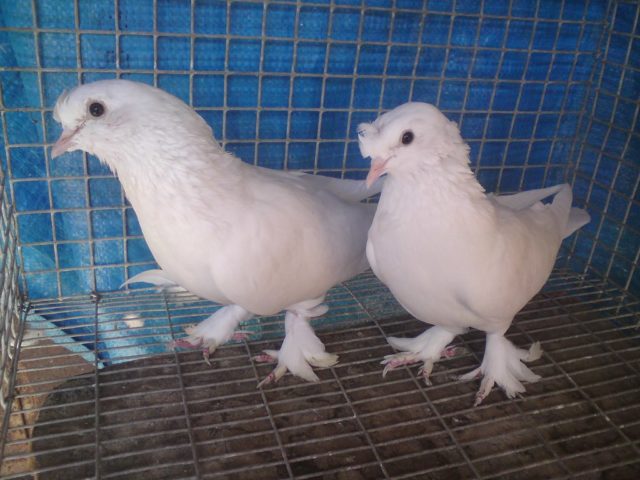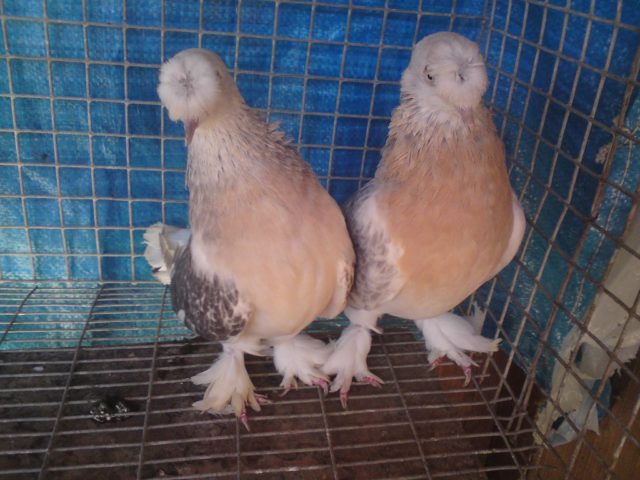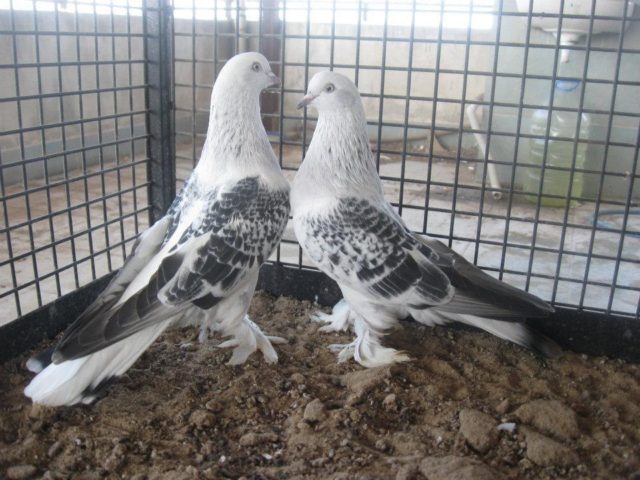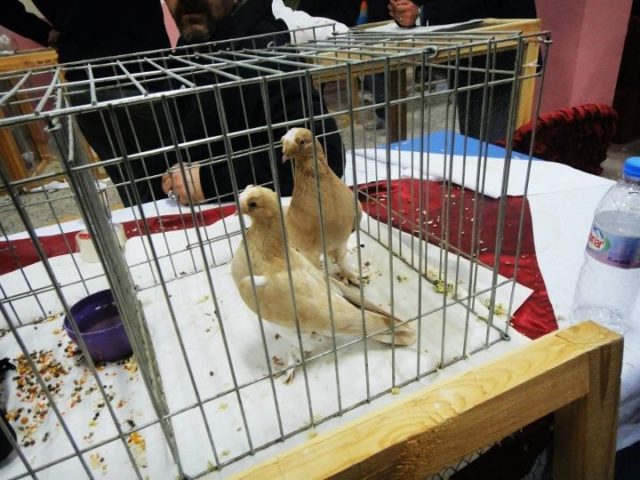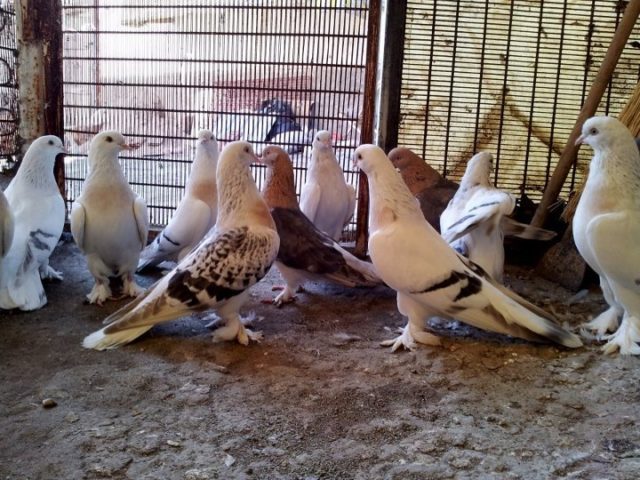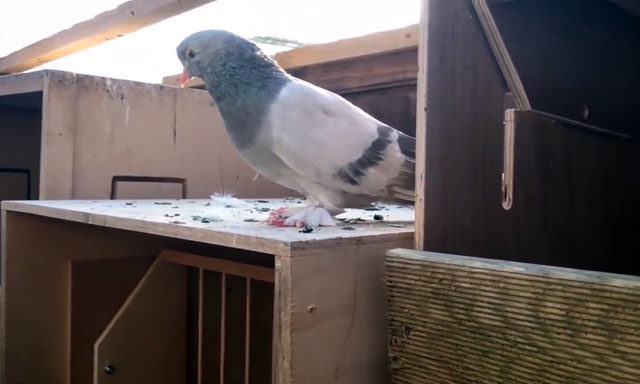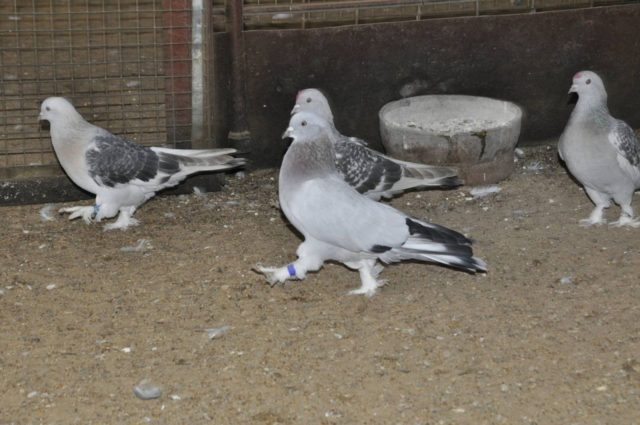Content
Takla pigeons are high-flying decorative pigeons, which are classified as slaughter pigeons. The characteristic "slaughter" of many people who are not familiar with the intricacies of pigeon breeding may be misleading, but the name has nothing to do with raising birds for slaughter or participating in pigeon fights. "Fighting" - emitting battle, flapping their wings during the game. Birds, when going up, make repeated somersaults over their heads and at the same time loudly flap their wings.
History of Turkish pigeons
Turkey is the main breeding center for the breed, while at the same time acting as a supplier of birds to other countries. It was the Turks who bred the Takla pigeons a thousand years ago.
The progenitors of purebred representatives of the Takla breed came to the territory of modern Turkey from China, the lands on which Kazakhstan is now located, and the Mongolian steppes. It happened in the XI century, as a result of the migration of the Seljuk tribes. The tumbling birds brought by the nomads attracted the attention of the Turkish sultan. Soon the palace of the ruler of Turkey, where curiosities gathered, was inhabited by these exotic birds with "fluffy" legs and forelocks, and after the Sultan, the tradition of keeping pigeons was taken up by his subjects. Over time, the Takla breed standard was developed. Soon the species split into varieties that differ from each other in the type of plumage ("forelocks", "eyebrows", "boots" on the legs) and color. Nevertheless, white individuals are still considered the reference pigeons of the Turkish Takla breed.
Russian fighting pigeon breeds at different times originated from the Turkish Takla. The first species began to appear after these birds were brought to Russia by the Kuban Cossacks as foreign trophies.
Features of Turkish Takla pigeons
Turkish Takla pigeons are represented by a huge number of colors and varieties. They are distinguished by their flying abilities: endurance, play, uniqueness of drawing and combat. They are trainable, intelligent birds with excellent memory and outstanding topographic skills. They are not lost, and if this happens, then the pigeons can easily find their way home.
The characteristics of the Takla breed include high demands on care and the need for regular training. If you do not deal with birds, they begin to be lazy, gain weight and turn into ordinary domestic pigeons. Chicks begin training from the first weeks of life - this is how genetic abilities can be revealed and consolidated.
Flight characteristics
All suits of Takla pigeons have merits, which include a description of their flight with the game:
- The height of the post is 18-22 m.
- The flight of Takla pigeons can last from morning until the end of the day, about 8-10 hours. White doves show the longest flight possible.
- During the game, the birds enter the pole not once, but several times in a row.
- The battle cycles are repeated at intervals of 2-5 hours.
- During a fight, Turkish pigeons have the ability to return to their starting position several times in a row.
- The best representatives of the Takla breed are capable of a landing game during the summer - pigeons at a certain moment hover in the air at an angle of 90 ° C and lower their heads, and their legs are extended forward, as if they want to land.
- Birds perform somersaults every 60-90 cm, combining them with a lift, when the pigeons throw the body up.
- Some representatives of the Turkish breed are able to carry out a screw fight, during which they rotate their body in a circle, soaring into the sky as if in a spiral.
The speed with which Takla pigeons go into battle differs from one species to another. In addition, birds show fighting skills in different ways - some reveal their potential within a month, while other pigeons train for several years.
Takla pigeon suits
There are various classifications of these birds. The suits of Takla pigeons and their varieties are classified according to the name of the region where they were bred:
- Miro;
- Eflaton;
- Sivash;
- Boz;
- Sabuni.
According to their external characteristics, groups of Takla pigeons are distinguished:
- forelock;
- nose-toed;
- two-legged;
- mustache;
- smooth-headed.
There is no single reference standard for Takla pigeons in terms of external characteristics, however, when choosing a bird, the color and type of plumage does not matter. The emphasis here is on the drawing of flight and endurance, and the best performance is observed in white Turkish pigeons. They are considered a specimen of the breed.
Common features include thick plumage on the legs. The Turkish Takla have noticeable "boots", but if they are lush, then this affects their flying abilities. Turkish Takla have a light physique: they have a slender, neat body, a moderately developed chest and a small head.
The color of birds is represented by a wide range of colors: there are white, black, red, bronze, bluish, gray and variegated Takla pigeons. Separately, variegated birds and color are distinguished, in which the head and tail are lighter than the main color of the feathers.
A brief description of the popular Takla varieties with photos of typical flowers for these species of pigeons is presented below.
Mardin
Mardin is the largest low-flying subspecies of the Takla breed. The Mardins have a gray color, but there are black and black-and-white pigeons. The game of birds has been described as very picturesque. Professional breeders compare Mardin pigeons with English turmans.
Urfa
Urfa - yellowish-buffy or brown with a bluish tint, which sometimes turns into black. There are pigeons with "belts". A rare color is bluish gray. The flight qualities of the Urfa subtype are no different from most other Takla species.
Sivash
Sivash differs in appearance by a pronounced forelock on the head and a white tail. Years are characterized by a shorter duration, but the birds beat more often and harder during the game.
Ankara
Ankara is one of the miniature Takla. The color is different: silver, gray, yellow, white, black, brown and smoky. The game is standard.
Antalya
Antalya is another miniature variety of fighting Turkish pigeons, along with Ankara. They are distinguished by their preference for single flights, although the fighting breeds are gregarious.
Diyarbakir
Diyarbakir is considered to be a decorative variety of Turkish pigeons. They are distinguished by their rounded shape and chubiness. The color of pigeons is very different.
Malatya
Malatya is mostly motley pigeons. There are no specimens with monochromatic plumage among Malatya. The fighting qualities of pigeons are excellent; in the game, birds use their legs, in addition to wings.
Konya
The game of Konya is characterized by single somersaults, the pillar game is not typical for them. By its appearance, the variety is distinguished by the small size of the beak.
Trabzon
Gray-brown pigeons, usually forelock.Preference is given to individuals with a light spot on the chest. The flight of the Turkish pigeons Trabzon is circular.
Mavi
Takla Mavi pigeons in the main light colors: gray, ocher, white, gray. Mavi pigeons often have stripes on the wings.
Miro
In flight, the Takla Miro Turkish pigeons do not stand out, but their color is quite remarkable. These are mainly birds of dark color, but there are individuals with gray back and wings, a neck with a greenish tint, and an ocher chest.
Keeping Takla pigeons
Turkish pigeons of the Takla breed are very gentle and whimsical creatures. It is important to remember this before buying birds, as caring for them takes a lot of time and effort.
Takla pigeons make high demands on the structure of the cage, diet and sanitary standards. In addition, representatives of the breed must be regularly trained, if possible, without missing a single lesson, otherwise the pigeons will quickly become lazy and lose their skills.
Primary requirements
In order for birds to have optimal conditions for development, you need to adhere to the requirements:
- Takla pigeons cannot be kept with other breeds. Moreover, these birds are not kept together with homogenous individuals that have distinctive generic characteristics. In other words, forelocked Turkish pigeons and smooth-headed pigeons should be kept isolated from each other, in order to avoid accidental crossing.
- Turkish Takla - painful pigeons. If at least one individual becomes infected with something, the disease can quickly become widespread and move on to other pigeons. To prevent this from happening, the sick bird is isolated at the first sign of malaise.
- The aviary is kept clean and tidy. The roosts are constantly polished to remove feces, the floor and sections are also regularly cleaned, 2 times a week. Once a month, the poultry house is completely disinfected with a solution of potassium permanganate and slaked lime.
- Training is a prerequisite for the development of fighting breeds. Birds are not allowed out in heavy rain or fog, but this is the only exception. You don't need to skip classes.
- The aviary should be light and spacious, and the equipment for working with pigeons should be clean.
- In winter, the dovecote should be warm, in summer it should be cool. The best materials for building a dovecote are wood or brick. From the inside, it is lined with solid shields and putty. The surfaces should be free of knots and large cracks.
Place of Containment
For breeding the Takla breed, a spacious cage or aviary is built, which is placed on the street or in a room if birds are bred in an apartment. Takla do not keep Turkish pigeons on the balcony.
The size of the enclosure is calculated based on the size of the flock: for each bird there is at least 50 cm² of floor space and 1.5 m3 of air space. This will give the pigeons enough room to perform the simplest maneuvers. If you keep birds in close quarters, they begin to behave sluggishly and become oppressed. In addition, in crowded areas, the likelihood of an outbreak of disease increases - birds quickly contaminate confined spaces.
Separate cells from wooden boxes are placed in the aviary. Their sizes are calculated so that the pigeons fit entirely inside. Additionally, a perch is attached to each section, otherwise it will be inconvenient for the birds to sit in the cells.
Additionally, a notch is attached to the cage if it is located on the street. It is a rectangular frame upholstered with mesh on top. The notch is attached with the open side to the rods of the aviary, and the other - to the exit window. There are two types of taphole: one-section and two-section.
Feeding Takla pigeons
The diet of Turkish pigeons depends on how large the beak of a particular Takla species is:
- short - up to 15 mm in length;
- medium - from 15 to 25 mm;
- long - 25 mm or more.
This is important because it limits the physiological ability of birds to consume different feeds. Breeds with short beaks find it difficult to handle large grains or crops such as peas without additional chopping. On the contrary, long-billed Takla pigeons find it difficult to peck small grains. Birds with an average beak size are in the best position - they practically do not experience difficulties while eating different feeds.
The recommended diet for short-billed Takla looks like this:
- millet in a shell;
- crushed wheat;
- Vika;
- small lentils;
- crushed barley;
- small varieties of peas;
- hemp seeds;
- flax seeds.
The composition of the feed mixture for long-billed Takla includes:
- barley;
- wheat;
- beans;
- peas;
- beans;
- corn;
- flax seeds;
- hemp seeds.
In addition, the birds are fed juicy feed and the water in the drinking bowl is regularly refreshed.
The birds are fed according to one of the following schemes:
- The feeder is filled gradually, adding the additive as it is eaten. If not a feed mixture is given, but individual crops are poured into the feeder, they start with oats, barley and wheat with millet, then peas, beans or corn come, and feeding with seeds of oil plants ends. The advantage of such a feeding scheme is that it saves feed: the birds do not carry the leftovers around the cage, and nothing remains in the bowl either.
- A pre-weighed amount of feed is poured into the feeder in accordance with all standards. The leftovers after feeding are discarded. This method saves time for the breeder, as he does not need to monitor how the bird is eating and adding new portions, but it affects the cost of unused feed. In addition, it is so difficult to notice if an individual refuses food, which may serve as the first sign of illness. It is with this algorithm of food delivery that you can view the onset of the disease.
Automatic feeders for feeding Turkish Takla should never be used. The breed is prone to overeating, they have a poorly developed sense of satiety. The auto feeder is always full of food. As a result, pigeons quickly gain weight, become lazy and soon lose their flying qualities. This feed is more suitable for keeping meat breeds that need to gain weight quickly.
When breeding fighting breeds, food is strictly according to the schedule, and the frequency of feeding depends on the time of year.
In summer and spring, Takla pigeons are fed 3 times a day:
- at 6 am;
- at noon;
- at 8 pm.
In winter and autumn, the number of meals is reduced by up to 2 times:
- at 8 am;
- at 5 pm.
The daily feed rate for Turkish Takla is 30-40 g in winter and 50 g in summer.
Breeding pigeons of the Turkish Takla breed
Before proceeding with the breeding of Takla, they equip a nesting place and a steam box. Box dimensions: 80 x 50 x 40 cm.After mating, it is turned into a nest box - for this, 2 nests with a diameter of 25 cm and sides 8 cm high are placed inside.
For 1.5-2 months of the beginning of the breeding season, the flock is seated according to gender - this is done so that the birds gain strength before mating.
Reproduction of domestic breeds occurs in two ways:
- Natural (random), in which the pigeons choose their own pair - the male chooses the female, and she answers or ignores his courtship. Clutching with this method of reproduction begins earlier, the percentage of hatchability is higher when compared with artificial breeding.
- Artificial (compulsory) - breeding based on the selection of a pair by the breeder according to their appearance or ability to fly.The disadvantages of this method are that pigeons later begin to lay eggs, fertility is lower, and males behave aggressively. The advantage of forced breeding is the better quality of the offspring.
During the breeding season, the male and female are placed in a steam box. Whether mating has taken place can be determined by the behavior of the birds after they are released into the wild. If the male has covered the dove, they become inseparable and follow each other. In this case, material for building a nest is laid out in the aviary: dry leaves, straw, small twigs, woolen threads. The male will collect material, the female will start building the nest.
2 weeks after mating, the dove lays the first egg, and this usually happens in the early morning or before 12 noon. In a clutch there are no more than two eggs, in young pigeons - one. Egg weight 20 g.
The pigeon pair incubates eggs in turns, and the male does it mainly in the morning, the rest of the time the female sits in the nest.
The incubation period lasts on average 19-20 days, but if the weather is warm, then this time is reduced to 17 days. A chick is born 10 hours after the blunt end of the egg is cracked. If after this time the chick cannot get out of the shell, he needs help.
The chick weighs 8-12 g. While it dries up, the parents warm it up with the heat of their bodies. After 2-3 hours, the piglet is able to eat.
Takla pigeons in Russia
In Russia, there are few specialized breeding centers for Turkish Takla pigeons. Of course, there are also amateur breeders, but in this case there is a risk of fraud. Basically, the breeding of the Takla breed is carried out by breeders of the Krasnodar and Stavropol Territories.
Conclusion
Takla pigeons are a popular breed of Turkish fighting pigeons and one of the very first. All Russian species of fighting birds originated from it. There is no single description of the exterior for this breed, since the appearance of the birds is very different depending on the subspecies: there are “forelock” Takla pigeons, “browed”, “mustachioed” ones. They are also varied in color. The main difference between Takla and other species is its unique flight pattern and endurance.
You can learn more about the Takla Turkish fighting pigeons from the video:
